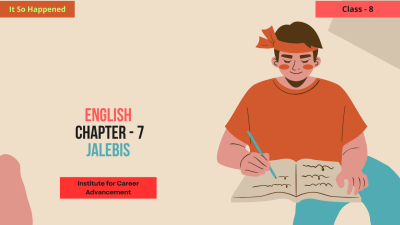Course description
"Jalebis" is a short story in the Class 8 English curriculum, written by Premchand, one of India's most celebrated writers. This story focuses on themes of childhood, desires, and the innocent yet powerful emotions of children. It explores the relationship between a father and his son, centered around the son’s strong craving for a treat – jalebis. The story is rich in its portrayal of human emotions, simple pleasures, and societal norms, all while highlighting the moral lessons about parental love, the significance of sharing, and understanding the deeper needs behind simple desires.
1. Story Summary:
"Jalebis" tells the story of a young boy who craves a treat of jalebis, a popular Indian sweet. The boy’s desire for the sweet is so intense that it drives him to ask his father for it. The father, a man of modest means, is unable to fulfill his son’s wish, which creates a sense of tension between them. The story unfolds with the father’s internal conflict between wanting to satisfy his son's desire and the limitations of his own financial situation. The narrative focuses on the emotional struggle and how, in the end, the father and son share a quiet moment of mutual understanding and love.
The story encapsulates the universal emotions associated with parental sacrifice, unconditional love, and the innocence of childhood desires.
2. Themes:
Parental Sacrifice: The father’s internal conflict highlights the sacrifices that parents often make for their children, even if it means they themselves have to go without.
Desire and Satisfaction: The boy's longing for jalebis represents the innocence and purity of children's desires, and the story reflects on how such simple desires are often deeply meaningful to them.
Love and Understanding: The father’s love for his son is evident in his efforts to comfort and care for him, even when he cannot meet the son's desires.
Class and Society: The story subtly touches upon social and economic inequalities, as the father's inability to afford jalebis reflects the struggles of lower-income families.
Emotional Bond: The connection between the father and son is at the heart of the story. It is the emotional bond that sustains their relationship despite the momentary disappointment.
3. Key Characters:
The Boy: A young, innocent child who yearns for the sweet treat of jalebis. His desire symbolizes the pure and innocent cravings children often have for simple pleasures.
The Father: A loving but financially constrained parent who desires to make his son happy but is unable to afford the treat due to his modest means. His internal emotional conflict highlights the deep love he has for his son.
4. Plot Overview:
The Boy’s Desire: The story begins with the boy’s intense craving for jalebis. His desire is sparked by seeing someone else eating them, and he pleads with his father to buy some for him.
The Father’s Struggle: The father, aware that he cannot afford the sweets, feels torn. He wants to fulfill his son's wish but is constrained by his financial limitations.
The Emotional Conflict: The boy’s persistent request brings out the father’s emotions, showing how a parent's love often involves silent sacrifices.
Resolution and Understanding: The story concludes with the father’s quiet resignation to not being able to fulfill his son’s wish, and the boy, in his innocence, accepting the situation. The bond between them remains strong, based on love and understanding.
5. Lessons and Morals:
Understanding Parental Sacrifice: The story teaches children to understand the emotional struggles and sacrifices parents make for them.
Appreciating Simple Pleasures: It also highlights how the simple joys, such as eating a sweet treat, hold great importance for children, and how parents often strive to make their children happy despite financial constraints.
Love and Emotional Bonds: The story reflects on the strength of emotional bonds, where love is not necessarily about fulfilling every material desire but about understanding and support.
Emotional Growth and Maturity: The story encourages children to develop emotional maturity, particularly in understanding their parents' limitations and expressing gratitude for their love and sacrifices.
"জেলেবিস" হল ভারতের অন্যতম বিখ্যাত লেখক প্রেমচাঁদ রচিত অষ্টম শ্রেণির ইংরেজি পাঠ্যক্রমের একটি ছোটগল্প। এই গল্পটি শৈশব, আকাঙ্ক্ষা এবং শিশুদের নির্দোষ অথচ শক্তিশালী আবেগের উপর দৃষ্টি নিবদ্ধ করে। এটি একজন পিতা এবং তার পুত্রের মধ্যে সম্পর্কের অন্বেষণ করে, যা একটি ট্রিট-জিলেবির জন্য পুত্রের প্রবল আকাঙ্ক্ষাকে কেন্দ্র করে। গল্পটি মানুষের আবেগ, সরল আনন্দ এবং সামাজিক নিয়মের চিত্রায়নে সমৃদ্ধ, যেখানে পিতামাতার ভালবাসা, ভাগ করে নেওয়ার তাৎপর্য এবং সাধারণ আকাঙ্ক্ষার পিছনে গভীর চাহিদা বোঝার বিষয়ে নৈতিক পাঠ তুলে ধরা হয়েছে।
1টি। গল্পের সারসংক্ষেপঃ "জেলেবিস" একটি অল্পবয়সী ছেলের গল্প বলে যে জনপ্রিয় ভারতীয় মিষ্টি জিলেবির জন্য আকুল আকাঙ্ক্ষী। মিষ্টিটির জন্য ছেলেটির আকাঙ্ক্ষা এতটাই তীব্র যে এটি তাকে তার বাবার কাছে এটি চাইতে প্ররোচিত করে। বাবা, একজন বিনয়ী মানুষ, তার ছেলের ইচ্ছা পূরণ করতে অক্ষম, যা তাদের মধ্যে উত্তেজনার অনুভূতি তৈরি করে। গল্পটি তার ছেলের আকাঙ্ক্ষা পূরণ করতে চাওয়া এবং তার নিজের আর্থিক পরিস্থিতির সীমাবদ্ধতার মধ্যে বাবার অভ্যন্তরীণ দ্বন্দ্বের সাথে উন্মোচিত হয়। আখ্যানটি আবেগগত সংগ্রামের উপর দৃষ্টি নিবদ্ধ করে এবং কীভাবে, শেষ পর্যন্ত, পিতা এবং পুত্র পারস্পরিক বোঝাপড়া এবং ভালবাসার একটি শান্ত মুহূর্ত ভাগ করে নেয়।
গল্পটি পিতামাতার ত্যাগ, নিঃশর্ত প্রেম এবং শৈশবের ইচ্ছার নির্দোষতার সাথে যুক্ত সর্বজনীন আবেগকে অন্তর্ভুক্ত করে।
2. বিষয়বস্তুঃ পিতামাতার আত্মত্যাগঃ পিতার অভ্যন্তরীণ দ্বন্দ্ব সেই ত্যাগকে তুলে ধরে যা পিতামাতারা প্রায়শই তাদের সন্তানদের জন্য করেন, এমনকি যদিও এর অর্থ তাদের নিজেরাই এর বাইরে যেতে হয়।
আকাঙ্ক্ষা এবং সন্তুষ্টিঃ জিলেবির জন্য ছেলেটির আকাঙ্ক্ষা শিশুদের আকাঙ্ক্ষার নির্দোষতা এবং বিশুদ্ধতার প্রতিনিধিত্ব করে এবং গল্পটি প্রতিফলিত করে যে কীভাবে এই ধরনের সাধারণ আকাঙ্ক্ষা তাদের কাছে প্রায়শই গভীরভাবে অর্থপূর্ণ হয়।
ভালবাসা এবং বোঝাপড়াঃ পুত্রের আকাঙ্ক্ষা পূরণ করতে না পারলেও তাকে সান্ত্বনা ও যত্ন নেওয়ার প্রচেষ্টায় পুত্রের প্রতি পিতার ভালবাসা স্পষ্ট হয়।
শ্রেণী ও সমাজঃ গল্পটি সূক্ষ্মভাবে সামাজিক ও অর্থনৈতিক বৈষম্যকে স্পর্শ করে, কারণ বাবার জিলেবি বহন করার অক্ষমতা নিম্ন আয়ের পরিবারের সংগ্রামকে প্রতিফলিত করে।
আবেগগত বন্ধন-বাবা ও ছেলের মধ্যে সংযোগ গল্পের কেন্দ্রবিন্দুতে রয়েছে। ক্ষণিকের হতাশা সত্ত্বেও এই আবেগগত বন্ধনই তাদের সম্পর্ককে টিকিয়ে রাখে।
3. মূল চরিত্রসমূহঃ
ছেলেটিঃ একটি অল্পবয়সী, নিষ্পাপ শিশু যে জিলেবির মিষ্টি খাবারের জন্য আকুল আকাঙ্ক্ষা করে। তাঁর আকাঙ্ক্ষা শিশুদের প্রায়শই সহজ সুখের জন্য বিশুদ্ধ এবং নির্দোষ আকাঙ্ক্ষার প্রতীক।
পিতাঃ একজন প্রেমময় কিন্তু আর্থিকভাবে সীমাবদ্ধ বাবা যিনি তার ছেলেকে সুখী করতে চান কিন্তু তার বিনয়ী উপায়ের কারণে চিকিৎসা করতে অক্ষম। তার অভ্যন্তরীণ আবেগগত দ্বন্দ্ব তার ছেলের প্রতি তার গভীর ভালবাসাকে তুলে ধরে।
4. প্লট ওভারভিউঃ
দ্য বয় 'স ডিজায়ারঃ গল্পটি শুরু হয় ছেলেটির জিলেবির প্রতি তীব্র আকাঙ্ক্ষা দিয়ে। অন্য কাউকে সেগুলি খেতে দেখে তার আকাঙ্ক্ষা জাগিয়ে ওঠে এবং সে তার বাবার কাছে তার জন্য কিছু কেনার জন্য অনুরোধ করে।
পিতার সংগ্রামঃ বাবা জানেন যে তিনি মিষ্টির সামর্থ্য রাখেন না, তিনি বিদীর্ণ বোধ করেন। সে তার ছেলের ইচ্ছা পূরণ করতে চায় কিন্তু তার আর্থিক সীমাবদ্ধতার দ্বারা সীমাবদ্ধ।
আবেগগত দ্বন্দ্বঃ ছেলেটির অবিরত অনুরোধ বাবার আবেগকে প্রকাশ করে, যা দেখায় যে কীভাবে একজন পিতামাতার ভালবাসা প্রায়শই নীরব ত্যাগের সাথে জড়িত।
সমাধান এবং বোঝাপড়াঃ ছেলের ইচ্ছা পূরণ করতে না পেরে বাবার নীরব পদত্যাগের মাধ্যমে গল্পটি শেষ হয় এবং ছেলেটি তার নির্দোষতায় পরিস্থিতি মেনে নেয়। প্রেম এবং বোঝাপড়ার উপর ভিত্তি করে তাদের মধ্যে বন্ধন দৃঢ় থাকে।
5. শিক্ষা ও নৈতিকতাঃ
পিতামাতার আত্মত্যাগ বোঝাঃ গল্পটি শিশুদের তাদের জন্য পিতামাতারা যে মানসিক সংগ্রাম এবং ত্যাগ স্বীকার করেন তা বুঝতে শেখায়।
সহজ আনন্দের প্রশংসা করাঃ এটি আরও তুলে ধরে যে কীভাবে মিষ্টি খাবার খাওয়ার মতো সাধারণ আনন্দগুলি শিশুদের জন্য অত্যন্ত গুরুত্বপূর্ণ এবং কীভাবে বাবা-মায়েরা প্রায়শই আর্থিক সীমাবদ্ধতা সত্ত্বেও তাদের সন্তানদের সুখী করার জন্য প্রচেষ্টা করে।
প্রেম এবং আবেগগত বন্ধন-গল্পটি আবেগগত বন্ধনের শক্তিকে প্রতিফলিত করে, যেখানে প্রেম প্রতিটি বস্তুগত আকাঙ্ক্ষা পূরণ করার জন্য নয় বরং বোঝাপড়া এবং সমর্থন সম্পর্কে।
সংবেদনশীল বৃদ্ধি এবং পরিপক্কতাঃ গল্পটি শিশুদের সংবেদনশীল পরিপক্কতা বিকাশ করতে উৎসাহিত করে, বিশেষ করে তাদের পিতামাতার সীমাবদ্ধতা বোঝার ক্ষেত্রে এবং তাদের ভালবাসা ও ত্যাগের জন্য কৃতজ্ঞতা প্রকাশ করার ক্ষেত্রে।



















